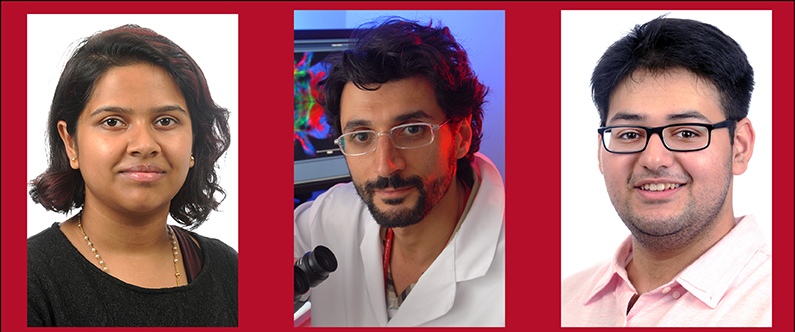WCM-Q students help with development of minimally invasive breast reconstruction surgery
 Gabriala Andrews, Dr. Jeremie Arash Tabrizi and Danyal Ahsan
Gabriala Andrews, Dr. Jeremie Arash Tabrizi and Danyal Ahsan
Student researchers at WCM-Q have contributed to better understanding of a minimally invasive breast reconstruction surgery for recovering breast cancer patients.
The highly innovative new surgical technique involves taking fat tissue from the hip or abdominal area and injecting it into the breast over the course of a series of short operations, each lasting less than one hour. While it has been used now for several years for many patients, it is not yet considered as gold standard protocol.
Dr. Jeremie Arash Tabrizi, WCM-Q’s professor of genetic medicine, obstetrics and gynecology, and Dr. Kaïs Razzouk, gynecologist/oncological ourgeon at the Santa Maria Breast Institute in Nice, France, have set-up a specific research program with the goal of demonstrating the efficiency of the technique, called autologous fat graft.
Fourth-year medical students Gabriala Andrews and Danyal Ahsan analyzed thousands of data points to provide valuable information to Drs. Tabrizi and Razzouk, allowing them to adjust the procedure to maximize its effectiveness, minimize the risk of complications and safeguard the mental health of patients.
Dr. Tabrizi said: “The students did fantastic work in analyzing a very large amount of data to give Dr. Razzouk and myself extremely valuable guidance. Their input has been remarkably useful to our work to refine and optimize this new procedure.”
Reconstruction of the breast or breasts after a mastectomy and radiotherapy treatment is an important part of the recovery process for many women who have had breast cancer, helping to provide psychological ‘closure’ on a distressing experience. The new approach is far less invasive than the two most common surgical breast reconstruction procedures, in which a flap of tissue and muscle is taken from either the back or the abdomen and grafted into the breast. These operations can take up to five hours or more, inflict significant scarring, have a long recovery time, and usually require a stay of several nights in hospital.
In contrast, the new approach causes minimal scarring and can be performed on an outpatient basis, allowing patients to have the surgery and go home the same day. The process also helps repair tissue damaged by radiation treatment, making insertion of a prosthesis more likely to succeed, should the patient wish to pursue that option.
Dr. Tabrizi said that the students analyzed a variety of data points, such as the volume of fat that was transferred from the hips to the breast in each procedure and compared this with the outcomes of the procedure, based on factors such as patient satisfaction, cosmetic appearance and incidence of complications such as bleeding or infection. This analysis allowed the surgeons to fine-tune the volume of fat they transferred to achieve the best overall results.
Another key finding of the students’ research related to the communication with the patient. Because the process is based on a gradual reconstruction, patients sometimes felt disappointed or underwhelmed by the results of the first procedure, the students found. To counter this, Dr. Tabrizi and Dr. Razzouk developed a new communications protocol to help patients understand that the process takes a little longer than the conventional surgery but that in the fullness of time it achieves equal or better cosmetic results while being far less invasive and carrying less risk of complications. This small innovation in the communications strategy significantly improved levels of patient satisfaction.
Dr. Tabrizi and Dr. Razzouk have now performed the new procedure approximately 300 times between them at two facilities in France, one in Nice and one in Paris.
Student Gabriala said: “It was extremely rewarding to be able to contribute to such an exciting and worthwhile innovation in reconstructive surgery for recovering breast cancer patients.”